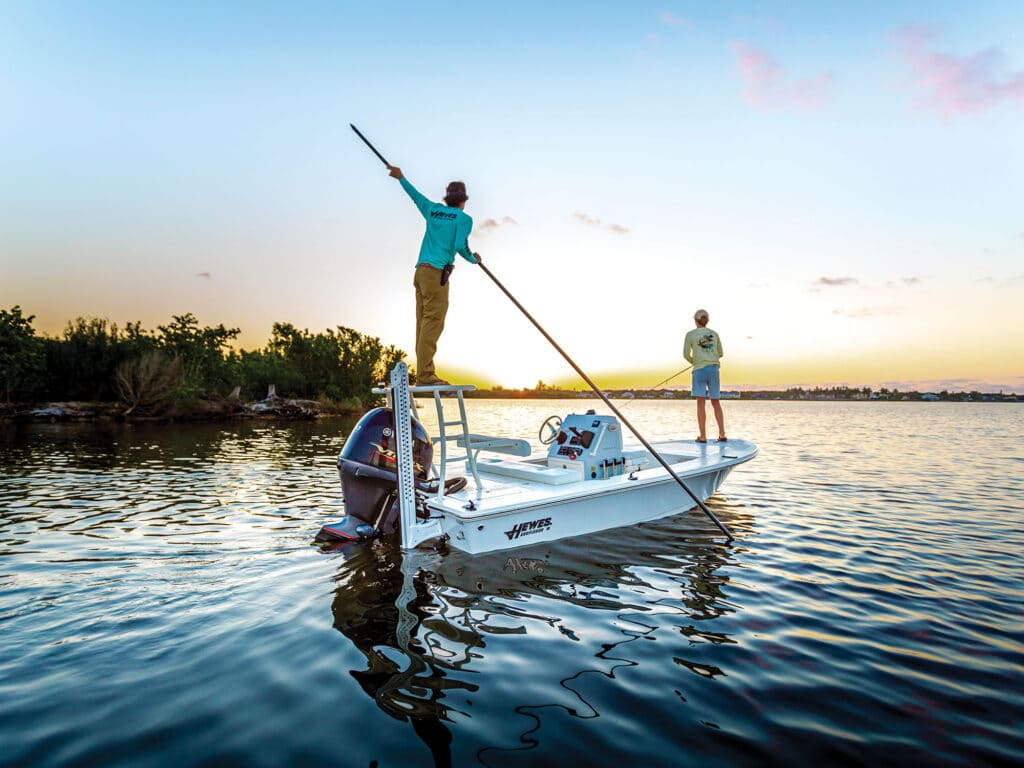
The advent of the remote-controlled trolling motor might be one of the greatest fishing innovations ever. It allows anglers to do previously impossible things. But while some might have thought it would make the push pole another victim of automation, poles still have a vital role in the hunt for skittish fish in skinny water. Knowing when to go from one to the other is key.
Don’t Cut the Grass
Seagrasses act as nurseries for aquatic animals. Turtle grass, in particular, is a hot topic because it’s been disappearing at an alarming rate, which has led to the collapse of fishing in certain areas. It’s increasingly important to reverse this trend. So, if a trolling motor is leaving chopped salad in its wake, go to the pole.
Shallow-Water Stealth
In shallow, clear water, the fish feel vulnerable. If there’s any sound, shadow or vibration, they will act like the Road Runner and vamoose in a cloud of silt. This is another scenario where poling is the best option, but only if done skillfully. Successful poling takes practice to minimize the scrunching sound of the pole on the bottom and avoid banging it against the boat. Those new to poling will likely do better using a trolling motor until their skills improve. Practice poling in between bites when the fish are gone.
Wind and Tide
There are times when the wind is blowing and the tide is ripping enough that poling alone won’t cut it, especially if fishing on a larger boat. Some captains use a stern-mounted trolling motor to augment poling. Evidence suggests a trolling motor on its lowest power setting and running at a steady speed affects fish less than speeding up and slowing down frequently. Rookie polers would do better with a trolling motor at a low, steady speed when the wind or tide is strong, using the pole only to slightly alter course.
Depth of Water
In deeper and murkier water, using a trolling motor is the way to go. It allows boating anglers to cover more area, which should lead to more opportunities. Fish feel safer when they have ample water above and below for maneuvering. And a lack of clarity provides cover for fish, which adds to their comfort level.
Trolling motors are superior because they can be programmed to follow contours, and the angler can control the trolling motor with a remote fob, allowing everyone on board, including the captain, to fish. For those fishing solo, poling and then picking up a rod to cast involves too many moving parts. If fishing alone and poling is a must, doing it from the bow makes it easier.
Read Next: How to Pole a Skiff

Species of Fish
Although any fish in shallow water tends to spook more than a fish swimming in deep water, bonefish, tarpon and permit tend to be warier than redfish and trout. There’s also anecdotal evidence that older fish and resident populations under heavy fishing pressure have learned the sound of a trolling motor means danger.
Trolling-Motor Pros
- Gives the ability to cover more water
- Can be programmed to follow a route
- Never gets tired (until the battery fails)
- Many can be controlled from anywhere on the boat with a remote control fob
- A live-sonar transducer can be attached to the shaft to provide a movable view of what’s below and forward
Trolling-Motor Cons
- Can bump the bottom or scare fish if used in really shallow water
- If used aggressively, the variable noise and resultant bow wake can spook fish
- Can hurt seagrass
- Motors can break down
Push-Pole Pros
- In skillful hands, it’s the stealthiest method
- Those poling usually stand high on a platform, which helps in spotting fish
- Never breaks down
- Working a push pole is great exercise
- Can be used for jousting with other bored captains when the bite is off
Push-Pole Cons
- Requires manual labor
- Less overall control of the boat
- Hard to fish by yourself
- Can bang on the deck when deploying or stowing
- Can be noisy against hard bottom
Learning when to pole and when to use the trolling motor is mostly a matter of experience. Personal observation of how fish react to the sound and vibration of a trolling motor will dictate when it’s better to use the push pole. One thing’s for certain: There will always be a time and a place for this form of manual override.
Brushless Trolling Motors are Quiet. But…
In 2019, the Lowrance Ghost and Garmin Force were unveiled, which both use quieter, brushless motors. But they are also among the most expensive, starting at $3,499 for the Lowrance and $3,550 for the Garmin. The max shaft length for the Garmin is 57 inches, and the Lowrance has a 60-inch model, which may be too short for some boats. The real deal breaker for the Lowrance Ghost is that using it in salt water voids the warranty, though use in brackish water is OK when an owner adds a factory-authorized sacrificial anode to the shaft.









